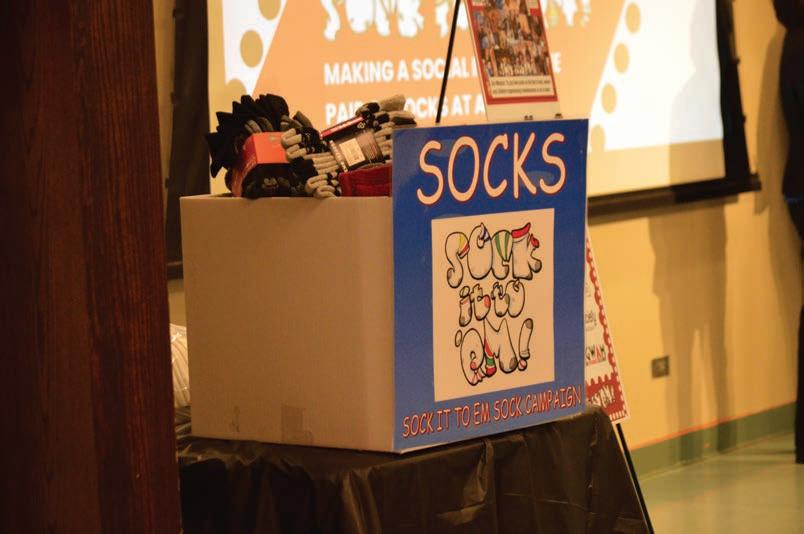
3 minute read
COVID pushed Colorado nonprofits to their limits
BY MONTE WHALEY THE COLORADO SUN
Colorado nonpro ts took a beating during the COVID-19 pandemic, bleeding volunteers and employees who were either forced to stay home or were terri ed of leaving their homes for fear they would get infected by the virus.
“We had older and retired volunteers who had to stay home because they were the most vulnerable to the virus,” said Dayna Scott, executive director of Broom eld FISH, a nonpro t providing help with food and housing. “ ere were real fears about death. No one knew what was going to happen day to day.”
Local food banks that help feed and clothe low-income and homeless people were hit especially hard. Grocery store shelves emptied almost overnight and businesses and food banks, including FISH, shuttered for more than a year. Nonpro ts had to pivot, sometimes in 24 hours, to hand out groceries and other donated staples to clients driving through their parking lots. e rapid turnaround needed to keep things running at FISH burned out many sta members, Scott said. “For some people it was the breaking point. e turnover was brutal.”
Scott said she and her remaining sta stayed clear-eyed about FISH’s mission. ey continued to help residents with rental and other nancial assistance and distributed food to families. In 2022, 12,553 people were served, up from 12,190 in 2021 and about 12,000 in 2020 a big jump from the 7,057 helped in 2018.
“We knew what we had to do,” said Scott, who shares her narrow o ce with a sleepy dog named Sami.
Scott manages a $6.6 million budget, seven paid sta ers and 30 community partnerships while bringing in corporate donors and steering clients to legal and housing help. Feeding families is a top priority for Scott and her sta , and in 2021, FISH distributed 1.5 million pounds of food to hungry people in Broom eld.
She brushes o the notion that she could earn a heftier paycheck if she used her skills for a big business. “I was never a corporate person,” Scott said. “I like to think I do more good by keeping 100 people from starving to death at the end of the day.”
State and local nonpro t o cials say they don’t know exactly how many sta members and volunteers they lost during the worst of the COVID pandemic. Marc Cowell, executive director of Outreach United Resource Center in Longmont, said although few of his peers left during COVID, there is little doubt COVID bludgeoned the nonpro t.
“I can state that COVID-19 did take a very heavy toll on myself and most of my colleagues,” he said.
To ght burnout during and after the worst of the pandemic, the OUR Center stressed a work-life balance to allow sta ers plenty of time to get away and be with friends and family, Cowell said.
“ at goes a long way in helping retain not only executives but managers, and front-line personnel,” said Cowell, who heads OUR Center’s e orts to help people in the St. Vrain Valley get basic services like food and to help pay the rent.
Cowell typically logs more than 50 hours a week as executive director, but takes time in the spring to indulge in one of his passions: coaching baseball at Holy Family High School in Broom eld. Coaching helps restore his energy for his full-time job. “It’s nice to be able to take multiple days o at di erent times throughout the year to recharge my batteries.” gets a steady paycheck he depends on weekly visits to FISH to keep his own kitchen stocked.
He said the state’s nonpro t sta ers took COVID’s best shot and stubbornly bounced back to deliver goods and services to friends and neighbors hit hard by the virus.
“At the end of the day it is about our mission and helping the community that keeps us coming back,” Cowell said.
“I am glad FISH is here, thank God. What they do is incredible,” Wallace said in January. “ ey help people like me out but they don’t make me feel bad about it. I don’t know what this community would do without them.”
Now aid groups are preparing the loss of pandemic-related support e long and uncertain days and nights fueled by fears of the pandemic are mostly over for Scott and other nonpro t leaders. But now the state’s 20,000 nonpro ts face an even taller task of bridging the gap left by vanishing pandemic-era federal and state funds for shelter and food, said Paul Lhevine, president and CEO of the Colorado Nonpro t Association.
Colorado’s Emergency Rental Assistance Program, which distributed more than $300 million to 36,000 households, is ending this year, nonpro t directors say. Emergency allotments of Colorado Supplemental Nutrition Assistance Program, or SNAP, are also ending this month.
“ e work in the nonpro t sector is critical now more than ever,” Lhevine said. “ ere are gaps that remain to be lled.”

$5,001-$10,000 $10,001-$50,000 $50,001-$100,000 $100,001 +
Jobless for a year, Broom eld resident Dave Wallace pushes a shopping cart through the narrow aisles of FISH’s 12,500-square-foot marketplace for staples like bread, butter, fresh fruit and vegetables. Almost all the items are donated by local grocery stores and businesses. Wallace is looking for work in the restaurant industry, but until he
Broom eld FISH was started 60 years ago in a church basement by six women who wanted to provide food and clothing to the city’s poor, Scott said.

Women volunteers have always been the prime drivers behind many nonpro ts, but the tendency to pay them less is a main reason









